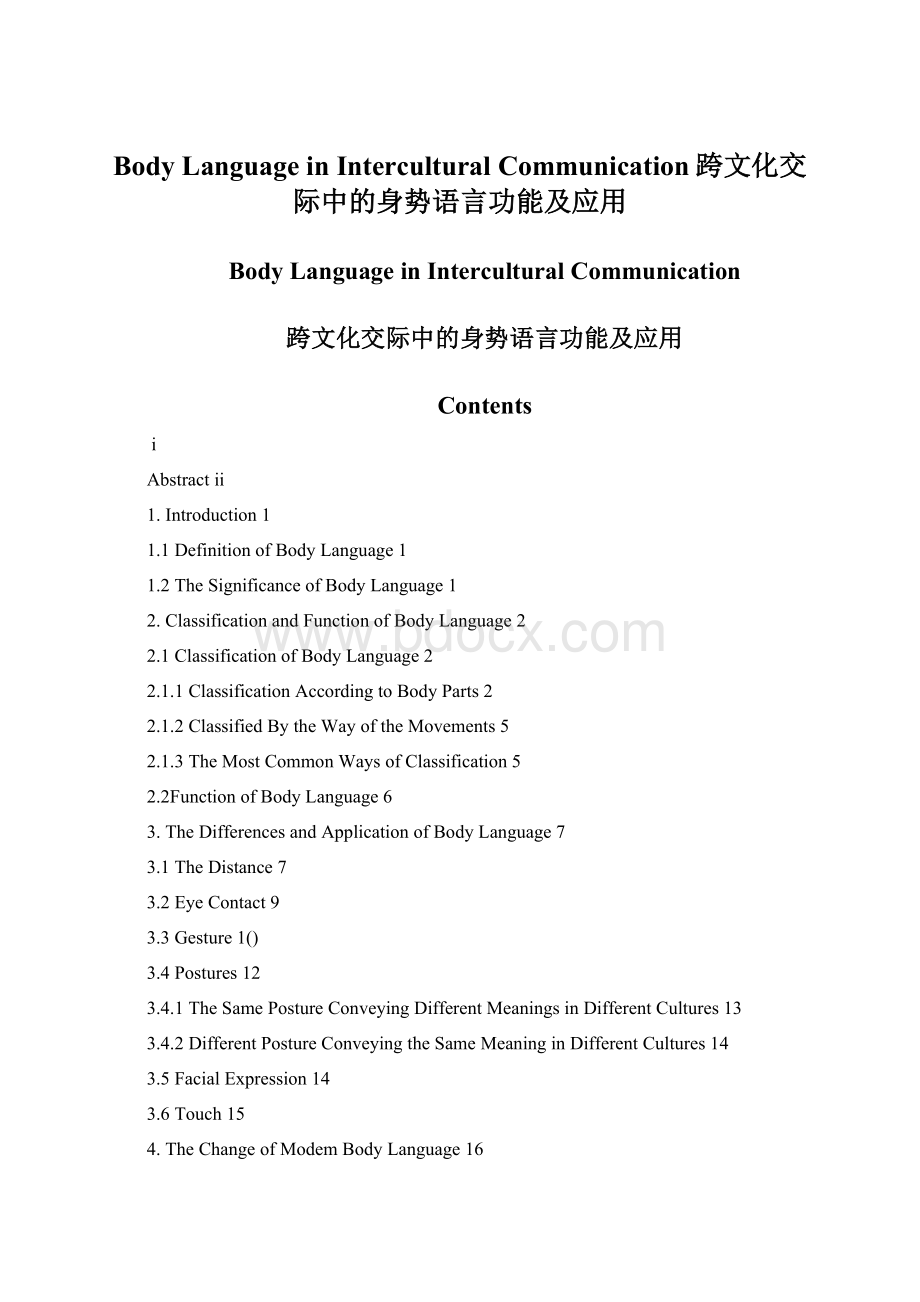 Body Language in Intercultural Communication跨文化交际中的身势语言功能及应用Word文档格式.docx
Body Language in Intercultural Communication跨文化交际中的身势语言功能及应用Word文档格式.docx
- 文档编号:19921300
- 上传时间:2023-01-12
- 格式:DOCX
- 页数:16
- 大小:30.20KB
Body Language in Intercultural Communication跨文化交际中的身势语言功能及应用Word文档格式.docx
《Body Language in Intercultural Communication跨文化交际中的身势语言功能及应用Word文档格式.docx》由会员分享,可在线阅读,更多相关《Body Language in Intercultural Communication跨文化交际中的身势语言功能及应用Word文档格式.docx(16页珍藏版)》请在冰豆网上搜索。

3.3Gesture1()
3.4Postures12
3.4.1TheSamePostureConveyingDifferentMeaningsinDifferentCultures13
3.4.2DifferentPostureConveyingtheSameMeaninginDifferentCultures14
3.5FacialExpression14
3.6Touch15
4.TheChangeofModemBodyLanguage16
5.Conclusion17
Bibliography18
身势语作为非语言交际,在跨文化交际屮有着不可忽视的重要作用。
无论一个人是坐着还是站着,是微笑亦或是眨眼,他都在传递着一定的信息。
每个国家都有自己的文化,所以身势语言也不尽相同。
即使是在同一个文化地域,有时候相同的身势语言可能也会有不同的含义。
例如,一个人微笑可能是因为他高兴,因为他想表达他对说话对象的友善、赞同和满意的态度,但也可能是心生不满而暗地讽刺所不自觉表露的出来的表情。
另外,当一个人极度悲伤的时候,也可能会用笑来掩饰内心的痛苦。
根据维基百科的记录,在一个人所传递出的信息中,有60%-70%的信息是来自于非语言的行为,E卩,身势语。
所以,只有了解其他国家和文化的人在说话同时所表现出来的手势、身体的姿势、眼神等等身势语,方能与他们进行准确有效的交流。
本文R在详细分析各肢体语言的功能,及在不同国家肢体语言的差异与应用,以达到流畅无阻,合理有效的屮外交流。
关键词:
身势语中外交流功能
Abstract
Bodylanguage,whichisthenonverbalbehavior,playsavitalroleininterculturalcommunication.Onesits,stands,smiles,winks,etc,allcanconveyhisinformation,attitudeandemotion.Eachbodylanguageindifferentcountryhasdifferentmeaning.Evenonparticularoccasion,thesamebodylanguageinthesamecountrymayhavedifferentsignificance.Forexample,wecanobserveone’ssmilewhenheisspeaking,whichcanindicatehishappiness,friendliness,approval,satisfaction,satire,dread,sadnessandetc.AccordingtoWikipedia,researchhassuggestedthatbetween60and70percentofallmeaningisderivedfromnonverbalbehavior.Soinordertocommunicateeffectivelyinaforeignlanguage,oneshouldknowthegestures,bodymovements,mannerisms,thataccompanyaparticularlanguage.Thispaperexplainsindetailonbodylanguagefunctions,differencesandapplicationininterculturalcommunicationforthepurposeoffluentandeffectivecommunication.
Keywords:
bodylanguage,interculturalcommunication,function
Introduction
DefinitionofBodyLanguage
AccordingtoWikipedia,Bodylanguageisaformofnonverbalcommunication,consistingofbodypose,gestures,andeyemovements.Humanssendandinterpretsuchsignalsunconsciously.Bodylanguage,whichgoeswiththeverbalcommunication,isanimportanttoolofhumancommunication.Ingeneralsense,thestudyofbodylanguagebeganin1950s.
TheOxfordAdvancedLearnersEnglish-ChineseDictionarydefinitionis:
“Bodylanguageisnotalanguageinthestrictsenseoftheword‘language’.Bodylanguageisexpressinghowonefeelsbyone’ssitting,standing,moving,etc,ratherbyword.”
TheOxfordEnglishdictionary(revised2005)definitionis:
”Bodylanguage,noun,theconsciousandunconsciousmovementsandposturesbywhichattitudesandfeelingsarecommunicated.Forexample:
hisintentwasclearlyexpressedinhisbodylanguage.”
TheSignificanceofBodyLanguage
Peoplecouldn’tlivewithouteachotherbecausewearesocialbeings.Assoonasweareincontactwithotherswearecommunicating.Itisquitesignificancetotalkwithotherwhenapersontellsotherswhohasbeenthewinnerofyesterday'
sfootballmatch,whenhewouldliketoknowhowhisson’sperformanceatschool,whenhebuysomebeefhometomakesteak.Still,thosewordsareinadequate.Forexample,wecan’ttelleachothereasilythathowwefeelabouteachother,orhowthewordofamessagetobeinterpreted.Tomakesuchmeaningmoreclearlyweusebodylanguage.SomebodywaswatchingTV,readingnewspapers,listeningtoradio,chatting,orevenheexpressedhislookwhilesittingsilently,whichindicatesthatheiscommunicatingwithothersallthetime.EvenLanguageisanimportanttoolofhumancommunication,itisnottheonlytool.Itisimpossiblenottohavetheverbalbehaviorinhuman’scommunication,butthenon-verbalcommunicationgoeswiththeverbal
communication.
Bodylanguageisdifferentfromspeakingbecauseitcouldbeusedbetweendifferentcountries.Inotherwords,everybodyusesbodylanguage.Thepeoplefromonecountrycancommunicatewithanotherfromoutsidecountrybybodylanguage.However,eachnationhashisowncultureandcustom.Thelargenumbersofitarequitedifferent,evenarecontrary.Thewrongwaytouseitmayleadtoconfusion.What’smore,thewrongbodylanguagethatusedbetweeninternationalcommunicationsmayleadtomisunderstandingbetweentwocountries.
Bodylanguageisawaytoexpressone’sinnerworldnoiselessly.Itisthemostoutstandingtoolofnon-verbalcommunication.Bodylanguageisirreplaceable,whichcanrepresentpeople’spsychologicalactivitiesrichlyandaccurately.Accordingtopsychologicalstatistics,the50%messagesareconveyedbybodylanguagebetweenaface-to-facecommunications.Evidencesaidthattheaveragetimeofspeakingonlyaccountfor10%ofthetimeofone’sdailycommunication.Itmeansthatthetimeforcommunicationexceptspeakingisusingbodylanguage,consciouslyornot.Evenonsomeoccasion,itisbettertousebodylanguagetoexpressthanspeaking.Justasanoldsayinggoes,themomentwhensilencecouldspeakmuchmorethanspeech.
ClassificationandFunctionofBodyLanguage
ClassificationofBodyLanguage
2.7.7ClassificationAccordingtoBodyParts
Thefirstkindisbodylanguageabouthandsandarm.Thiskindofbodylanguageisusedwithhands,armorfingers.Forexample,salute,snapone’sfingerat/insomebody’sface,layafingeronsomebody/something,thumbone’snoseatsomebody,thumbalift,andetc.Thesecondoneisaboutface.Italwaysexpressesbyeyebrows,eyes,noseormouth.Suchasmakesheep’seyesatsomebody,frown,pout,tipsomebodythewink,andetc.Thethirdkindisabouthead,whichoftendoitwithhead
asnodding.Thenisthefourthonewithshoulder.Forinstance,shrugone’sshoulder.Thelastbutnottheleastisthekindwithlegsuchasstampone’sfoot,keeldownandkick.Theauthormakesthefollowedtableforabetterunderstanding.
Partofbody
signal
Possiblemeanings(inlargemajority
ofcountries)
Handsand
arm
Fingerpointingata
person
Aggression,threat,emphasis
Handonheart
Believed
Fingerpointinginthe
air.Handchop
Emphasis
Forefingerandmiddle
fingercurvingupand
down
Quote-unquote
Indexfingerandthumb
touchingattips
Satisfaction,’OK’
Thumb(s)up
Positiveapproval,agreement,allwell
Thumb(s)down
Disapprovalfailure
Rubbinghandstogether
Anticipation,relish
Hand(s)clampedover
mouth
Suppression,shock
Touchingorscratching
nose,whilespeaking
Lyingorexaggeration
Crossedarms
Defensiveness,reluctance
Grippingownupper
arms
Insecurity
Onearmacrossbody
claspingotherarmby
side
Nervousness(womenusethisgesture.
Mentendnotto.)
Armsheldbehindbody
Confidence,authority
withhandsclasped
eyes
Lookingright
Creating,fabricating,guessing,lying,
storytelling
Lookingleft
Recalling,remembering,retrieving
‘facts’.
Directeyecontact
whenspeaking
Honesty,orfakedhonesty
whenlistening
Attentiveness,interest,attraction
Blinkingfrequently
Excitement,pressure
Blinkinginfrequently
Various(thissignalcanmean
differentmeaning.Itcanbesigned
unlesscombinewithothersignals)
Eyebrowraising
Greeting,recognition,
acknowledgement
Winking
Friendly,acknowledgement,
complicity(e.g.,sharingasecretor
joke)
laughter
Relaxation
Bitinglip
tension
Chewingpenorpencil
Self-comforting
Nailbiting
Frustration,suppression
Handclampedover
Suppression,holdingback,shock
Pastedsmile(Itis
appearsquicklyor
fixedlongerthana
naturalsmile,and
seemsnottoextendto
Fakedsmile
eyes.)
head
Headnodding
Agreement
Slowheadnodding
Attentivelistening
Fastheadnodding
Hurryup,impatience
Headheldhigh
Superiority,fearlessness,arrogance
Headshaking
Disagreement
Headdown
Negative,disinterested,defeat,
tiredness
Chinup
Pride,defiance,confidence
legs
Seated,legsclose
together
Nervousness,seriousness
Seated,withlegs
relaxedorPuttingone
legoveranotherwhen
sitting
Arbitrary,relaxed
2.1.2ClassifiedBytheWayoftheMovements
Bodylanguagefallsintothreecategoriesaccordingtodifferentmovements:
simple,complicated,andcompoundlanguage.
Simplebodylanguage,whichonlyneedsonemovementtofinishitsuchasnoddingandsnapthefingers.
Complicatedbodylanguage,whichneedsseveraldifferentactionstocomposeit.Forinstancemakethesignsofthecrossandswagger.
Compoundlanguage,which,isfinishedbyseveralsamemovementssuchasshakinghandsandclappingone’shands.
2.1.3TheMostCommonWaysofClassification
Intheinterculturalcommunication,themostcommonwaytoclassifythebodylanguageisbythemovementofhumanbody.Samovarusedtheterm“bodybehavior’’,
andclassifieditintoappearance,bodymovement,facialexpression,eyemanagement,touching,sub-language,andsoon.TheclassificationbyKnappisgesture,bodymovement,extremitiesmovement,handmovement,headmovement,facialexpression,eyemanagement,posture,andsoon.Brosnahanuse“gesture”torefertotouching,space,appearanceposture,bodybehavior,armmovement,legmovement,handmovement,headmovement,facialexpression,eyemanagement,noisyandsilentdecorations,theenvironment,andsoon.Fromallthesewaysofclassification,wecanknowthatbodylanguagemainlyincludesthemovementofeverypartofaman’sbody.This
- 配套讲稿:
如PPT文件的首页显示word图标,表示该PPT已包含配套word讲稿。双击word图标可打开word文档。
- 特殊限制:
部分文档作品中含有的国旗、国徽等图片,仅作为作品整体效果示例展示,禁止商用。设计者仅对作品中独创性部分享有著作权。
- 关 键 词:
- Body Language in Intercultural Communication跨文化交际中的身势语言功能及应用 Communication 文化 交际 中的 语言 功能 应用
 冰豆网所有资源均是用户自行上传分享,仅供网友学习交流,未经上传用户书面授权,请勿作他用。
冰豆网所有资源均是用户自行上传分享,仅供网友学习交流,未经上传用户书面授权,请勿作他用。
链接地址:https://www.bdocx.com/doc/19921300.html


 铝散热器项目年度预算报告.docx
铝散热器项目年度预算报告.docx
